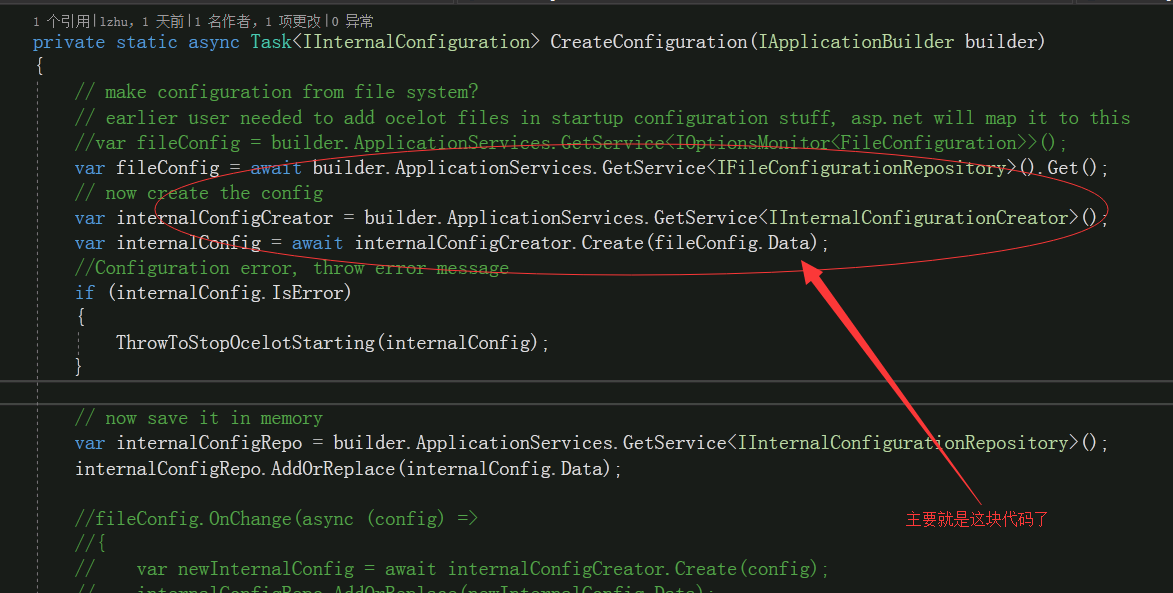上篇文章给大家分享了如何集成我写的一个Ocelot扩展插件把Ocelot的配置存储到数据库中。并没有对实现原理进行相应的阐述。今天抽空把实现的原理给大家说道说道。明白原理后,大家就可以自行改写进行扩展来满足自身需要了!
再次感觉张队的审稿,并给出的修改意见!
源码解析过程
大家可以自行分析Ocelot的源码,我通过分析ocelot的源码得出,如果要实现重写配置文件的方式,只需要写一个类来实现IFileConfigurationRepository这个接口即可。
代码如下:
/// <summary>
/// yilezhu
/// 2018.10.22
/// 实现从SQLSERVER数据库中提取配置信息
/// </summary>
public class SqlServerFileConfigurationRepository :
IFileConfigurationRepository
{
private readonly IOcelotCache<FileConfiguration> _cache;
private readonly IOcelotLogger _logger;
private readonly ConfigAuthLimitCacheOptions _option;
public SqlServerFileConfigurationRepository(ConfigAuthLimitCacheOptions option, IOcelotCache<FileConfiguration> cache, IOcelotLoggerFactory loggerFactory) {
_option = option;
_cache = cache;
_logger = loggerFactory.CreateLogger<SqlServerFileConfigurationRepository>();
}
public Task<Response> Set(FileConfiguration fileConfiguration)
{
_cache.AddAndDelete(_option.CachePrefix + "FileConfiguration", fileConfiguration, TimeSpan.FromSeconds(1800), "");
return Task.FromResult((Response)new OkResponse());
} /// <summary>
/// 提取配置信息
/// </summary>
/// <returns></returns>
public async Task<Response<FileConfiguration>> Get()
{
var config = _cache.Get(_option.CachePrefix + "FileConfiguration", ""); if (config != null)
{
return new OkResponse<FileConfiguration>(config);
}
#region 提取配置信息
var file = new FileConfiguration();
string glbsql = "select top 1 * from OcelotGlobalConfiguration where IsDefault=1"; //提取全局配置信息
using (var connection = new SqlConnection(_option.DbConnectionStrings))
{
var result = await connection.QueryFirstOrDefaultAsync<OcelotGlobalConfiguration>(glbsql);
if (result != null)
{
var glb = new FileGlobalConfiguration();
glb.BaseUrl = result.BaseUrl;
glb.DownstreamScheme = result.DownstreamScheme;
glb.RequestIdKey = result.RequestIdKey; if (!String.IsNullOrEmpty(result.HttpHandlerOptions))
{
glb.HttpHandlerOptions = result.HttpHandlerOptions.ToObject<FileHttpHandlerOptions>();
}
if (!String.IsNullOrEmpty(result.LoadBalancerOptions))
{
glb.LoadBalancerOptions = result.LoadBalancerOptions.ToObject<FileLoadBalancerOptions>();
}
if (!String.IsNullOrEmpty(result.QoSOptions))
{
glb.QoSOptions = result.QoSOptions.ToObject<FileQoSOptions>();
}
if (!String.IsNullOrEmpty(result.ServiceDiscoveryProvider))
{
glb.ServiceDiscoveryProvider = result.ServiceDiscoveryProvider.ToObject<FileServiceDiscoveryProvider>();
}
file.GlobalConfiguration = glb; //提取路由信息
string routesql = "select * from OcelotReRoutes where OcelotGlobalConfigurationId=@OcelotGlobalConfigurationId and IsStatus=1"; var routeresult = (await connection.QueryAsync<OcelotReRoutes>(routesql, new { OcelotGlobalConfigurationId=result.Id })).AsList(); if (routeresult != null && routeresult.Count > 0)
{
var reroutelist = new List<FileReRoute>(); foreach (var model in routeresult)
{
var m = new FileReRoute(); if (!String.IsNullOrEmpty(model.AuthenticationOptions))
{
m.AuthenticationOptions = model.AuthenticationOptions.ToObject<FileAuthenticationOptions>();
}
if (!String.IsNullOrEmpty(model.CacheOptions))
{
m.FileCacheOptions = model.CacheOptions.ToObject<FileCacheOptions>();
}
if (!String.IsNullOrEmpty(model.DelegatingHandlers))
{
m.DelegatingHandlers = model.DelegatingHandlers.ToObject<List<string>>();
}
if (!String.IsNullOrEmpty(model.LoadBalancerOptions))
{
m.LoadBalancerOptions = model.LoadBalancerOptions.ToObject<FileLoadBalancerOptions>();
}
if (!String.IsNullOrEmpty(model.QoSOptions))
{
m.QoSOptions = model.QoSOptions.ToObject<FileQoSOptions>();
}
if (!String.IsNullOrEmpty(model.DownstreamHostAndPorts))
{
m.DownstreamHostAndPorts = model.DownstreamHostAndPorts.ToObject<List<FileHostAndPort>>();
} //开始赋值
m.DownstreamPathTemplate = model.DownstreamPathTemplate;
m.DownstreamScheme = model.DownstreamScheme;
m.Key = model.Key;
m.Priority = model.Priority ?? 0;
m.RequestIdKey = model.RequestIdKey;
m.ServiceName = model.ServiceName;
m.Timeout = model.Timeout ?? 0;
m.UpstreamHost = model.UpstreamHost; if (!String.IsNullOrEmpty(model.UpstreamHttpMethod))
{
m.UpstreamHttpMethod = model.UpstreamHttpMethod.ToObject<List<string>>();
}
m.UpstreamPathTemplate = model.UpstreamPathTemplate;
reroutelist.Add(m);
}
file.ReRoutes = reroutelist;
}
} else
{ throw new Exception("未监测到配置信息");
}
} #endregion
if (file.ReRoutes == null || file.ReRoutes.Count == 0)
{ return new OkResponse<FileConfiguration>(null);
} return new OkResponse<FileConfiguration>(file);
}
}当然,既然我们已经重新实现了这个接口,那么就得进行相应的DI了。这里我们扩展下IOcelotBuilder方法,代码如下,主要就是进行相应的服务的DI:
/// <summary>
/// yilezhu
/// 2018.10.22
/// 基于Ocelot扩展的依赖注入
/// </summary>
public static class ServiceCollectionExtensions
{ /// <summary>
/// 添加默认的注入方式,所有需要传入的参数都是用默认值
/// </summary>
/// <param name="builder"></param>
/// <returns></returns>
public static IOcelotBuilder AddAuthLimitCache(this IOcelotBuilder builder, Action<ConfigAuthLimitCacheOptions> option) {
builder.Services.Configure(option);
builder.Services.AddSingleton(
resolver => resolver.GetRequiredService<IOptions<ConfigAuthLimitCacheOptions>>().Value); #region 注入其他配置信息
//重写提取Ocelot配置信息,
builder.Services.AddSingleton(DataBaseConfigurationProvider.Get); //builder.Services.AddHostedService<FileConfigurationPoller>();
builder.Services.AddSingleton<IFileConfigurationRepository, SqlServerFileConfigurationRepository>(); //注入自定义限流配置
//注入认证信息
#endregion
return builder;
}
}接下来就是重写,OcelotBuild里面配置文件的获取方式了。这里我选择的是对IApplicationBuilder进行扩展,因为这样方便做一些其他的事情,比如,重写限流,集成自定义的验证等等。具体代码如下:
/// <summary>
/// yilezhu
/// 2018.10.22
/// 扩展IApplicationBuilder,新增use方法
/// </summary>
public static class OcelotMiddlewareExtensions
{ /// <summary>
/// 扩展UseOcelot
/// </summary>
/// <param name="builder"></param>
/// <returns></returns>
public static async Task<IApplicationBuilder> UseAhphOcelot(this IApplicationBuilder builder) { await builder.UseAhphOcelot(new OcelotPipelineConfiguration()); return builder;
} /// <summary>
/// 重写Ocelot,带参数
/// </summary>
/// <param name="builder"></param>
/// <param name="pipelineConfiguration"></param>
/// <returns></returns>
public static async Task<IApplicationBuilder> UseAhphOcelot(this IApplicationBuilder builder, OcelotPipelineConfiguration pipelineConfiguration) { var configuration = await CreateConfiguration(builder);
ConfigureDiagnosticListener(builder);
return CreateOcelotPipeline(builder, pipelineConfiguration);
} private static async Task<IInternalConfiguration> CreateConfiguration(IApplicationBuilder builder)
{ // make configuration from file system?
// earlier user needed to add ocelot files in startup configuration stuff, asp.net will map it to this
//var fileConfig = builder.ApplicationServices.GetService<IOptionsMonitor<FileConfiguration>>();
var fileConfig = await builder.ApplicationServices.GetService<IFileConfigurationRepository>().Get(); // now create the config
var internalConfigCreator = builder.ApplicationServices.GetService<IInternalConfigurationCreator>();
var internalConfig = await internalConfigCreator.Create(fileConfig.Data); //Configuration error, throw error message
if (internalConfig.IsError)
{
ThrowToStopOcelotStarting(internalConfig);
} // now save it in memory
var internalConfigRepo = builder.ApplicationServices.GetService<IInternalConfigurationRepository>();
internalConfigRepo.AddOrReplace(internalConfig.Data); //fileConfig.OnChange(async (config) =>
//{
// var newInternalConfig = await internalConfigCreator.Create(config);
// internalConfigRepo.AddOrReplace(newInternalConfig.Data);
//});
var adminPath = builder.ApplicationServices.GetService<IAdministrationPath>();
var configurations = builder.ApplicationServices.GetServices<OcelotMiddlewareConfigurationDelegate>(); // Todo - this has just been added for consul so far...will there be an ordering problem in the future? Should refactor all config into this pattern?
foreach (var configuration in configurations)
{ await configuration(builder);
} if (AdministrationApiInUse(adminPath))
{ //We have to make sure the file config is set for the ocelot.env.json and ocelot.json so that if we pull it from the
//admin api it works...boy this is getting a spit spags boll.
var fileConfigSetter = builder.ApplicationServices.GetService<IFileConfigurationSetter>(); // await SetFileConfig(fileConfigSetter, fileConfig.Data);
}
return GetOcelotConfigAndReturn(internalConfigRepo);
}
private static bool AdministrationApiInUse(IAdministrationPath adminPath) {
return adminPath != null;
} //private static async Task SetFileConfig(IFileConfigurationSetter fileConfigSetter, IOptionsMonitor<FileConfiguration> fileConfig)
//{
// var response = await fileConfigSetter.Set(fileConfig.CurrentValue);
// if (IsError(response))
// {
// ThrowToStopOcelotStarting(response);
// }
//}
private static bool IsError(Response response)
{
return response == null || response.IsError;
}
private static IInternalConfiguration GetOcelotConfigAndReturn(IInternalConfigurationRepository provider)
{
var ocelotConfiguration = provider.Get();
if (ocelotConfiguration?.Data == null || ocelotConfiguration.IsError)
{
ThrowToStopOcelotStarting(ocelotConfiguration);
}
return ocelotConfiguration.Data;
}
private static void ThrowToStopOcelotStarting(Response config)
{
throw new Exception($"Unable to start Ocelot, errors are: {string.Join(",", config.Errors.Select(x => x.ToString()))}");
}
private static IApplicationBuilder CreateOcelotPipeline(IApplicationBuilder builder, OcelotPipelineConfiguration pipelineConfiguration)
{
var pipelineBuilder = new OcelotPipelineBuilder(builder.ApplicationServices); //重写自定义管道
pipelineBuilder.BuildAhphOcelotPipeline(pipelineConfiguration); var firstDelegate = pipelineBuilder.Build(); /*
inject first delegate into first piece of asp.net middleware..maybe not like this
then because we are updating the http context in ocelot it comes out correct for
rest of asp.net..
*/
builder.Properties["analysis.NextMiddlewareName"] = "TransitionToOcelotMiddleware";
builder.Use(async (context, task) =>
{
var downstreamContext = new DownstreamContext(context); await firstDelegate.Invoke(downstreamContext);
}); return builder;
}
private static void ConfigureDiagnosticListener(IApplicationBuilder builder)
{
var env = builder.ApplicationServices.GetService<IHostingEnvironment>(); var listener = builder.ApplicationServices.GetService<OcelotDiagnosticListener>();
var diagnosticListener = builder.ApplicationServices.GetService<DiagnosticListener>();
diagnosticListener.SubscribeWithAdapter(listener);
}
}这其中最主要的代码就是,重写配置文件获取这块。我在下面进行了截图,并圈出来了,大家自行查看吧。

代码重写好了。由于我们服务注册时通过扩展IOcelotBuilder,所以,我们需要在ConfigureServices方法引入Ocelot服务的时候比Ocelot多写一个方法,并传入相关的配置信息,如下所示:
services.AddOcelot()//注入Ocelot服务
.AddAuthLimitCache(option=> {
option.DbConnectionStrings = "Server=.;Database=Ocelot;User ID=sa;Password=1;";
});这里的目的就是为了注入我们实现了IFileConfigurationRepository接口的SqlServerFileConfigurationRepository这个类。
接下来就是在管道中使用我们重写的Ocelot服务了。如下所示,在Configure方法中按如下代码进行使用:
app.UseAhphOcelot().Wait();
好了,以上就是实现的整个过程了。经过这么一分析是不是觉得很简单呢。当然具体为什么按照上面处理就能够从数据库获取配置了呢,这个还需要你分析了源码后才能了解。我也只是给你引路,传达我实现的思路。
源码
https://github.com/yilezhu/Ocelot.ConfigAuthLimitCache
总结
今天抽空对上篇文章进行了补充说明,目的是给大家阐述下,配置文件存储到数据库中的实现过程及原理。让你能够根据自身需要来进行改写来满足你的业务需求。当然我也只是给你引路,具体为什么这样实现下就能够成功呢?答案在Ocelot的源码中。

 随时随地看视频
随时随地看视频



